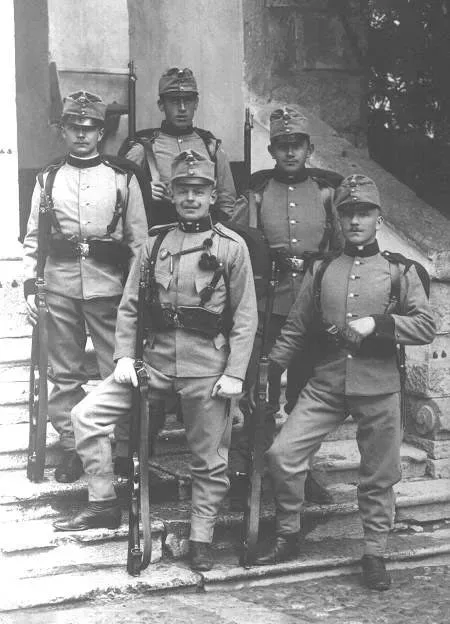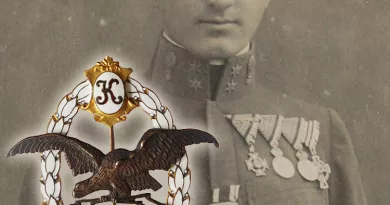Qualification lanyards
This section is directed by my friend Gábor Széplaki. The uploaded posts are written and designed by him. Thank you Gábor for your kind contribution. I think these badges also fit the site’s profile. The first time, we’re going to be a little off-topic, because we are not going to deal with the usual metal badges. We took the textile honors here. We’re about to add them to the first entry because these decorations started the row chronologically. However, some of the pictures also show the round performance badges that later became common!
The military merits were recognized in the army of the Austro-Hungarian Empire in the form of medals, both during the peace period and with the onset of war relations. Medals/crosses suspended on tape were primarily a visible distinguishing sign for officers to recognize their service. With the appearance of increasingly specialized disciplines and military professions there was a legitimate need to create accolades also for the crew. Signs that clearly proclaimed the proficiency and professional skill of the crew and petty officers within the given branch. These had two appearances. One was the introduction of strings and tassels with various textile materials introduced in the infantry and artillery. The other type was the round or oval brass badge.
Textile qualification marks
Appearance and design: the lanyard was made of 4 mm thick and 535 mm long wool cord, twisted in a braided length of 110 mm. The upper end of the twisted part had a smaller and thinner loop and a larger loop at the bottom. Under the larger loop was a tassel or ball made of wool, 35 mm in diameter. Two more cords of 110 mm length branched out with a smaller 30 mm diameter and a larger wool sphere with a diameter of 40 mm on each branch.

Wearing: The larger loop was tied to the shoulder ligament on the left shoulder. The smaller loop was fixed with the 3rd button of the jacket from above. When wearing a cape, the 2. button of the right row of buttons from above was used to fix the free-standing loop. With the appearance of metal badges, the small loop was hooked into the tab used to fasten it. Anchor badges have often been attached to the cord in case of technical troops. In many cases signal whistles were fixed to it by petty officers.

The color of the qualification lanyard depended on the army branches:
Various shades of red: worn by soldiers of the infantry regiments. The cherry red was regular in the Honvéd corps. The condition of the merit was that in a given training year the soldier had to successfully complete at least 3 basic exercises. The distinguishing mark could be worn by the soldier continuously until he successfully completed his annual training exercises. Grass green: it was worn by Feldjäger and Tiroler Jäger. From 1878 it was also used for the Landwehr regiments. The conditions for wearing were the same as those for the infantry regiments.
Steel green: it was earned by trained helmsman of the engineer troops. It could be worn after the successful completion of the helmsman course and demonstration of skills in boat handling and pontoon bridge construction. Dark Red: The engineering troops wore this color. The prestige of the honor is reflected by the low number of distinguished soldiers. Only 8-10 soldiers of a unit were decorated at the same time. Dark green: soldiers from the railway-building and signal regiments were awarded this colored lanyard. In order to win it, a successful exam had to be taken on the basics of signaling, line laying and blasting. In addition, it was also needed to demonstrate the ability of the construction of the railway line and the associated telegraph lines.
In 1906, the sniper lanyard was introduced, as the newly introduced 1895M Steyr rifle helped soldiers to meet the qualification requirements more easily. The new type of recognition was prepared with gold metal fibers and wool balls already known for previous shooting medals. Its appearance and wearing were the same as previous pieces. This honor was conditional on the award of the “base” rifleman decoration. In addition the soldiers had to hit 60% of the targets in the annual shooting drills. The decoration was introduced by the regular infantry, Honvéd Infantry Regiments and the Landwehr and the Feldjäger units. The difference in appearance was in the color of the wool tassels: red for the former and green for the latter.

Even after the war, the lanyard decoration continued to live within the Hungarian Royal Army until 1932 and was even expanded (with 1-2-3 middle wool tassels) – for soldiers with machine guns until 1944. It was used by the Army of the Republic of Austria from 1929 to 1938, and between 1962 and 1974.





Interesting combination: lanyard fixed to a Kappenabzeichen of the 59th IR. The badge was shown on this site in the post on Salzburg.
Good photograph with a very inventive solution.